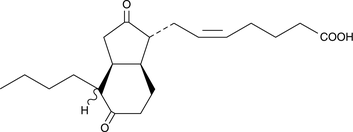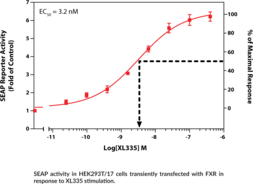Cayman
Showing 11851–12000 of 45550 results
-
Bicyclo prostaglandin E2 (bicyclo PGE2) is a stable breakdown product of PGE2 (Item No. 14010) and 13,14-dihydro-15-keto PGE2 (Item No. 14650). Bicyclo PGE2 is a stable, base-catalyzed transformation product of 13,14-dihydro-15-keto PGE2. 13,14-dihydro-15-keto PGE2 itself is a metabolite of PGE2 found in human plasma at a median level of 20-25 pg/ml.{182,4383} Due to the inherent instability of 13,14-dihydro-15-keto PGE2, it is advisable to quantify it as bicyclo PGE2 to estimate PGE2 biosynthesis or metabolism in vivo.{2571,581}
Brand:CaymanSKU:-Bicyclol is a hepatoprotective agent.{37151,37152,37153,37154} It has antiviral activity against hepatitis B (HBV), reducing viral DNA and the secretion of the HBV antigens HBsAg and HBeAg by 59 and 35%, respectively, in infected 2.2.15 HepG2 cells.{37151} In vivo, bicyclol reduces duck HBV (DHBV) DNA in DHBV-infected ducks at doses ≥0.4 g/kg. It also reduces the expression of TNF-α and the accumulation of lymphocytes in the liver in a mouse model of liver injury induced by concanavalin A (Item No. 14951).{37152} Oral administration of bicyclol prior to injection of diethylnitrosamine (DEN) and phenobarbital (PB; Item Nos. 9001494 | 20987) prevents formation of DEN/PB-induced hepatocellular carcinomas.{37153} It also reduces liver fibrosis in a rat model of bile duct ligation-induced hepatic fibrosis.{37154}
Brand:CaymanSKU:21551 -Out of stock
Bicyclol is a hepatoprotective agent.{37151,37152,37153,37154} It has antiviral activity against hepatitis B (HBV), reducing viral DNA and the secretion of the HBV antigens HBsAg and HBeAg by 59 and 35%, respectively, in infected 2.2.15 HepG2 cells.{37151} In vivo, bicyclol reduces duck HBV (DHBV) DNA in DHBV-infected ducks at doses ≥0.4 g/kg. It also reduces the expression of TNF-α and the accumulation of lymphocytes in the liver in a mouse model of liver injury induced by concanavalin A (Item No. 14951).{37152} Oral administration of bicyclol prior to injection of diethylnitrosamine (DEN) and phenobarbital (PB; Item Nos. 9001494 | 20987) prevents formation of DEN/PB-induced hepatocellular carcinomas.{37153} It also reduces liver fibrosis in a rat model of bile duct ligation-induced hepatic fibrosis.{37154}
Brand:CaymanSKU:21551 -Out of stock
Bicyclol is a hepatoprotective agent.{37151,37152,37153,37154} It has antiviral activity against hepatitis B (HBV), reducing viral DNA and the secretion of the HBV antigens HBsAg and HBeAg by 59 and 35%, respectively, in infected 2.2.15 HepG2 cells.{37151} In vivo, bicyclol reduces duck HBV (DHBV) DNA in DHBV-infected ducks at doses ≥0.4 g/kg. It also reduces the expression of TNF-α and the accumulation of lymphocytes in the liver in a mouse model of liver injury induced by concanavalin A (Item No. 14951).{37152} Oral administration of bicyclol prior to injection of diethylnitrosamine (DEN) and phenobarbital (PB; Item Nos. 9001494 | 20987) prevents formation of DEN/PB-induced hepatocellular carcinomas.{37153} It also reduces liver fibrosis in a rat model of bile duct ligation-induced hepatic fibrosis.{37154}
Brand:CaymanSKU:21551 -Out of stock
Bicyclomycin benzoate is an antibiotic produced by S. sapporonensis that inhibits Gram-negative bacteria, including E. coli, Klebsiella, Shigella, Salmonella, Citrobacter, E. cloacae, and the pathogenic group of Neisseria.{24917,24916} It is inactive against Proteus, P. aeruginosa, and Gram-positive bacteria.{24917,24916}
Brand:CaymanSKU:-Bicyclomycin benzoate is an antibiotic produced by S. sapporonensis that inhibits Gram-negative bacteria, including E. coli, Klebsiella, Shigella, Salmonella, Citrobacter, E. cloacae, and the pathogenic group of Neisseria.{24917,24916} It is inactive against Proteus, P. aeruginosa, and Gram-positive bacteria.{24917,24916}
Brand:CaymanSKU:-Bifenazate is a carbazate acaricide that provides 100% control of mites when used at a concentration of 25 ppm.{36331} It acts as a positive allosteric modulator of GABA receptors containing the resistance to dieldrin (Rdl) subunit homolog TuGABAR in T. urticae (spider mites), shifting the GABA-induced response from an EC50 value of 24.8 to 4.83 µM when used at a concentration of 30 µM.{36330} Formulations containing bifenazate have been used for the control of mites and for pesticide detection.
Brand:CaymanSKU:24147 - 100 mgAvailable on backorder
Bifenazate is a carbazate acaricide that provides 100% control of mites when used at a concentration of 25 ppm.{36331} It acts as a positive allosteric modulator of GABA receptors containing the resistance to dieldrin (Rdl) subunit homolog TuGABAR in T. urticae (spider mites), shifting the GABA-induced response from an EC50 value of 24.8 to 4.83 µM when used at a concentration of 30 µM.{36330} Formulations containing bifenazate have been used for the control of mites and for pesticide detection.
Brand:CaymanSKU:24147 - 25 mgAvailable on backorder
Bifenazate is a carbazate acaricide that provides 100% control of mites when used at a concentration of 25 ppm.{36331} It acts as a positive allosteric modulator of GABA receptors containing the resistance to dieldrin (Rdl) subunit homolog TuGABAR in T. urticae (spider mites), shifting the GABA-induced response from an EC50 value of 24.8 to 4.83 µM when used at a concentration of 30 µM.{36330} Formulations containing bifenazate have been used for the control of mites and for pesticide detection.
Brand:CaymanSKU:24147 - 50 mgAvailable on backorder
Bifenthrin is a synthetic pyrethroid insecticide that prolongs opening of sodium channels resulting in membrane depolarization and conductance block in the insect nervous system.{36375} It is effective against A. gambiae and C. quinquefasciatus mosquitos (LD50s = 0.15 and 0.16 ng/mg, respectively) and increases O. insidiosus mortality in treated corn and sorghum plants.{41760,41761} Bifenthrin exhibits aquatic toxicity, inducing reproductive defects and lethality in D. magna (LC50 = 12.4 µg/L).{41762} Acute oral administration of bifenthrin induces fine tremor, decreases motor activity and grip strength, and increases pawing and head shaking behaviors in rats, indicating typical Type I pyrethroid neurotoxicity.{41763} Bifenthrin (8 mg/kg) also decreases locomotor activity, induces anemia, elevates white blood cell counts, alanine transaminase (ALT), and superoxide dismutase (SOD), as well as decreases glutathione peroxidase (Gpx) activity in mice.{41764}
Brand:CaymanSKU:24057 - 10 mgAvailable on backorder
Bifenthrin is a synthetic pyrethroid insecticide that prolongs opening of sodium channels resulting in membrane depolarization and conductance block in the insect nervous system.{36375} It is effective against A. gambiae and C. quinquefasciatus mosquitos (LD50s = 0.15 and 0.16 ng/mg, respectively) and increases O. insidiosus mortality in treated corn and sorghum plants.{41760,41761} Bifenthrin exhibits aquatic toxicity, inducing reproductive defects and lethality in D. magna (LC50 = 12.4 µg/L).{41762} Acute oral administration of bifenthrin induces fine tremor, decreases motor activity and grip strength, and increases pawing and head shaking behaviors in rats, indicating typical Type I pyrethroid neurotoxicity.{41763} Bifenthrin (8 mg/kg) also decreases locomotor activity, induces anemia, elevates white blood cell counts, alanine transaminase (ALT), and superoxide dismutase (SOD), as well as decreases glutathione peroxidase (Gpx) activity in mice.{41764}
Brand:CaymanSKU:24057 - 25 mgAvailable on backorder
Bifenthrin is a synthetic pyrethroid insecticide that prolongs opening of sodium channels resulting in membrane depolarization and conductance block in the insect nervous system.{36375} It is effective against A. gambiae and C. quinquefasciatus mosquitos (LD50s = 0.15 and 0.16 ng/mg, respectively) and increases O. insidiosus mortality in treated corn and sorghum plants.{41760,41761} Bifenthrin exhibits aquatic toxicity, inducing reproductive defects and lethality in D. magna (LC50 = 12.4 µg/L).{41762} Acute oral administration of bifenthrin induces fine tremor, decreases motor activity and grip strength, and increases pawing and head shaking behaviors in rats, indicating typical Type I pyrethroid neurotoxicity.{41763} Bifenthrin (8 mg/kg) also decreases locomotor activity, induces anemia, elevates white blood cell counts, alanine transaminase (ALT), and superoxide dismutase (SOD), as well as decreases glutathione peroxidase (Gpx) activity in mice.{41764}
Brand:CaymanSKU:24057 - 5 mgAvailable on backorder
Bifenthrin is a synthetic pyrethroid insecticide that prolongs opening of sodium channels resulting in membrane depolarization and conductance block in the insect nervous system.{36375} It is effective against A. gambiae and C. quinquefasciatus mosquitos (LD50s = 0.15 and 0.16 ng/mg, respectively) and increases O. insidiosus mortality in treated corn and sorghum plants.{41760,41761} Bifenthrin exhibits aquatic toxicity, inducing reproductive defects and lethality in D. magna (LC50 = 12.4 µg/L).{41762} Acute oral administration of bifenthrin induces fine tremor, decreases motor activity and grip strength, and increases pawing and head shaking behaviors in rats, indicating typical Type I pyrethroid neurotoxicity.{41763} Bifenthrin (8 mg/kg) also decreases locomotor activity, induces anemia, elevates white blood cell counts, alanine transaminase (ALT), and superoxide dismutase (SOD), as well as decreases glutathione peroxidase (Gpx) activity in mice.{41764}
Brand:CaymanSKU:24057 - 50 mgAvailable on backorder
Bifeprunox is an atypical antipsychotic.{52217} It is a dopamine D2 receptor partial agonist and an agonist of the serotonin (5-HT) receptor subtype 5-HT1A (Kis = 2.2 and 9.3 nM, respectively).{52219,52218} Bifeprunox inhibits apomorphine-induced climbing behavior in mice (ED50 = 0.1 mg/kg) and the conditioned avoidance response in rats (ED50 = 0.8 mg/kg).{52218} It decreases basal prepulse inhibition of the acoustic startle response in rats by 42% when administered at a dose of 10 mg/kg.{52219}
Brand:CaymanSKU:29523 - 1 mgAvailable on backorder
Bifeprunox is an atypical antipsychotic.{52217} It is a dopamine D2 receptor partial agonist and an agonist of the serotonin (5-HT) receptor subtype 5-HT1A (Kis = 2.2 and 9.3 nM, respectively).{52219,52218} Bifeprunox inhibits apomorphine-induced climbing behavior in mice (ED50 = 0.1 mg/kg) and the conditioned avoidance response in rats (ED50 = 0.8 mg/kg).{52218} It decreases basal prepulse inhibition of the acoustic startle response in rats by 42% when administered at a dose of 10 mg/kg.{52219}
Brand:CaymanSKU:29523 - 10 mgAvailable on backorder
Bifeprunox is an atypical antipsychotic.{52217} It is a dopamine D2 receptor partial agonist and an agonist of the serotonin (5-HT) receptor subtype 5-HT1A (Kis = 2.2 and 9.3 nM, respectively).{52219,52218} Bifeprunox inhibits apomorphine-induced climbing behavior in mice (ED50 = 0.1 mg/kg) and the conditioned avoidance response in rats (ED50 = 0.8 mg/kg).{52218} It decreases basal prepulse inhibition of the acoustic startle response in rats by 42% when administered at a dose of 10 mg/kg.{52219}
Brand:CaymanSKU:29523 - 5 mgAvailable on backorder
Bifonazole is a topically-active imidazole antifungal compound that has broad spectrum activity in vitro against dermatophytes, molds, yeasts, dimorphic fungi, and some Gram-positive bacteria.{30284,25584} It is effective in the treatment of experimental dermatophytic and Candida in animals.{25584} Bifonazole is also a potent inhibitor of cytochrome P450 aromatase (Ki = 68 nM, IC50 = 270 nM), which catalyzes the biosynthesis of estrogens from androgens.{30283} When applied topically in animals, it demonstrates prolonged retention time in skin with minimal percutaneous absorption, thus minimizing its effect on aromatase.{25584}
Brand:CaymanSKU:-Available on backorder
Bifonazole is a topically-active imidazole antifungal compound that has broad spectrum activity in vitro against dermatophytes, molds, yeasts, dimorphic fungi, and some Gram-positive bacteria.{30284,25584} It is effective in the treatment of experimental dermatophytic and Candida in animals.{25584} Bifonazole is also a potent inhibitor of cytochrome P450 aromatase (Ki = 68 nM, IC50 = 270 nM), which catalyzes the biosynthesis of estrogens from androgens.{30283} When applied topically in animals, it demonstrates prolonged retention time in skin with minimal percutaneous absorption, thus minimizing its effect on aromatase.{25584}
Brand:CaymanSKU:-Available on backorder
Bifonazole is a topically-active imidazole antifungal compound that has broad spectrum activity in vitro against dermatophytes, molds, yeasts, dimorphic fungi, and some Gram-positive bacteria.{30284,25584} It is effective in the treatment of experimental dermatophytic and Candida in animals.{25584} Bifonazole is also a potent inhibitor of cytochrome P450 aromatase (Ki = 68 nM, IC50 = 270 nM), which catalyzes the biosynthesis of estrogens from androgens.{30283} When applied topically in animals, it demonstrates prolonged retention time in skin with minimal percutaneous absorption, thus minimizing its effect on aromatase.{25584}
Brand:CaymanSKU:-Available on backorder
Bifonazole is a topically-active imidazole antifungal compound that has broad spectrum activity in vitro against dermatophytes, molds, yeasts, dimorphic fungi, and some Gram-positive bacteria.{30284,25584} It is effective in the treatment of experimental dermatophytic and Candida in animals.{25584} Bifonazole is also a potent inhibitor of cytochrome P450 aromatase (Ki = 68 nM, IC50 = 270 nM), which catalyzes the biosynthesis of estrogens from androgens.{30283} When applied topically in animals, it demonstrates prolonged retention time in skin with minimal percutaneous absorption, thus minimizing its effect on aromatase.{25584}
Brand:CaymanSKU:-Available on backorder
BIIB-057 is a potent inhibitor of the non-receptor tyrosine kinase Syk (IC50 = 1 nM).{28676} It displays at least 80-fold selectivity for Syk over other kinases. BIIB-057 blocks B cell receptor-mediated cell signaling and activation in whole blood (IC50s = 0.27 and 0.28 µM, respectively), as well as Fcɛ receptor 1-mediated basophil degranulation (IC50 = 0.15 µM).{28676} It antagonizes chemokine production, cell migration, and survival of chronic lymphocytic leukemia (CLL) cells after B cell receptor activation and synergistically enhances the action of fludarabine (Item No. 14128) in killing CLL cells.{28677,28678} BIIB-057 is orally bioavailable, as it produces dose-dependent anti-inflammatory activity in two rodent models of rheumatoid arthritis.{28676} It also prevents splenomegaly and inhibits non-Hodgkin lymphoma tumor growth in a xenograft model.{28678}
Brand:CaymanSKU:-Available on backorder
BIIB-057 is a potent inhibitor of the non-receptor tyrosine kinase Syk (IC50 = 1 nM).{28676} It displays at least 80-fold selectivity for Syk over other kinases. BIIB-057 blocks B cell receptor-mediated cell signaling and activation in whole blood (IC50s = 0.27 and 0.28 µM, respectively), as well as Fcɛ receptor 1-mediated basophil degranulation (IC50 = 0.15 µM).{28676} It antagonizes chemokine production, cell migration, and survival of chronic lymphocytic leukemia (CLL) cells after B cell receptor activation and synergistically enhances the action of fludarabine (Item No. 14128) in killing CLL cells.{28677,28678} BIIB-057 is orally bioavailable, as it produces dose-dependent anti-inflammatory activity in two rodent models of rheumatoid arthritis.{28676} It also prevents splenomegaly and inhibits non-Hodgkin lymphoma tumor growth in a xenograft model.{28678}
Brand:CaymanSKU:-Available on backorder
BIIB-057 is a potent inhibitor of the non-receptor tyrosine kinase Syk (IC50 = 1 nM).{28676} It displays at least 80-fold selectivity for Syk over other kinases. BIIB-057 blocks B cell receptor-mediated cell signaling and activation in whole blood (IC50s = 0.27 and 0.28 µM, respectively), as well as Fcɛ receptor 1-mediated basophil degranulation (IC50 = 0.15 µM).{28676} It antagonizes chemokine production, cell migration, and survival of chronic lymphocytic leukemia (CLL) cells after B cell receptor activation and synergistically enhances the action of fludarabine (Item No. 14128) in killing CLL cells.{28677,28678} BIIB-057 is orally bioavailable, as it produces dose-dependent anti-inflammatory activity in two rodent models of rheumatoid arthritis.{28676} It also prevents splenomegaly and inhibits non-Hodgkin lymphoma tumor growth in a xenograft model.{28678}
Brand:CaymanSKU:-Available on backorder
BIIB-057 is a potent inhibitor of the non-receptor tyrosine kinase Syk (IC50 = 1 nM).{28676} It displays at least 80-fold selectivity for Syk over other kinases. BIIB-057 blocks B cell receptor-mediated cell signaling and activation in whole blood (IC50s = 0.27 and 0.28 µM, respectively), as well as Fcɛ receptor 1-mediated basophil degranulation (IC50 = 0.15 µM).{28676} It antagonizes chemokine production, cell migration, and survival of chronic lymphocytic leukemia (CLL) cells after B cell receptor activation and synergistically enhances the action of fludarabine (Item No. 14128) in killing CLL cells.{28677,28678} BIIB-057 is orally bioavailable, as it produces dose-dependent anti-inflammatory activity in two rodent models of rheumatoid arthritis.{28676} It also prevents splenomegaly and inhibits non-Hodgkin lymphoma tumor growth in a xenograft model.{28678}
Brand:CaymanSKU:-Available on backorder
BIIB021 is a potent, orally-available inhibitor of Hsp90 (Ki = 1.7 nM) that induces the degradation of oncoproteins, including HER2 (EC50 = 38 nM), while up-regulating the expression of Hsp70 and Hsp27.{29827,29829} It is cytotoxic to cancer cells and, when administered orally to mice, inhibits growth of xenograft tumors.{29827,29829,29828} BIIB021 suppresses growth in various lymphoma cells but not in normal lymphocytes and induces apoptosis in a myelodysplastic syndrome cell line.{29826,29830,29828}
Brand:CaymanSKU:-Available on backorder
BIIB021 is a potent, orally-available inhibitor of Hsp90 (Ki = 1.7 nM) that induces the degradation of oncoproteins, including HER2 (EC50 = 38 nM), while up-regulating the expression of Hsp70 and Hsp27.{29827,29829} It is cytotoxic to cancer cells and, when administered orally to mice, inhibits growth of xenograft tumors.{29827,29829,29828} BIIB021 suppresses growth in various lymphoma cells but not in normal lymphocytes and induces apoptosis in a myelodysplastic syndrome cell line.{29826,29830,29828}
Brand:CaymanSKU:-Available on backorder
BIIB021 is a potent, orally-available inhibitor of Hsp90 (Ki = 1.7 nM) that induces the degradation of oncoproteins, including HER2 (EC50 = 38 nM), while up-regulating the expression of Hsp70 and Hsp27.{29827,29829} It is cytotoxic to cancer cells and, when administered orally to mice, inhibits growth of xenograft tumors.{29827,29829,29828} BIIB021 suppresses growth in various lymphoma cells but not in normal lymphocytes and induces apoptosis in a myelodysplastic syndrome cell line.{29826,29830,29828}
Brand:CaymanSKU:-Available on backorder
BIIB021 is a potent, orally-available inhibitor of Hsp90 (Ki = 1.7 nM) that induces the degradation of oncoproteins, including HER2 (EC50 = 38 nM), while up-regulating the expression of Hsp70 and Hsp27.{29827,29829} It is cytotoxic to cancer cells and, when administered orally to mice, inhibits growth of xenograft tumors.{29827,29829,29828} BIIB021 suppresses growth in various lymphoma cells but not in normal lymphocytes and induces apoptosis in a myelodysplastic syndrome cell line.{29826,29830,29828}
Brand:CaymanSKU:-Available on backorder
Bikaverin is a fungal metabolite originally isolated from F. oxysporum f. sp. lycopersici that has diverse biological activities, including antiprotozoal, nematocidal, antiproliferative, and fungicidal properties.{46194,46195,46196,46197} It is active against L. braziliensis when used at a concentration of 0.15 µg/ml and against B. xylophilus at a concentration of 100 µg/ml.{46195} It inhibits proliferation of NCI-H460, MIA PaCa-2, MCF-7, and SF-268 cells (IC50s = 0.43, 0.26, 0.42, and 0.38 µM, respectively).{46196} Bikaverin inhibits the growth of certain plant pathogenic fungi, including R. solani, P. capsici, P. infestans, and M. grisea (IC50s = P. infestans and P. recondita, respectively, when applied at a concentration of 300 µg/ml.
Brand:CaymanSKU:27467 - 1 mgAvailable on backorder
Bikaverin is a fungal metabolite originally isolated from F. oxysporum f. sp. lycopersici that has diverse biological activities, including antiprotozoal, nematocidal, antiproliferative, and fungicidal properties.{46194,46195,46196,46197} It is active against L. braziliensis when used at a concentration of 0.15 µg/ml and against B. xylophilus at a concentration of 100 µg/ml.{46195} It inhibits proliferation of NCI-H460, MIA PaCa-2, MCF-7, and SF-268 cells (IC50s = 0.43, 0.26, 0.42, and 0.38 µM, respectively).{46196} Bikaverin inhibits the growth of certain plant pathogenic fungi, including R. solani, P. capsici, P. infestans, and M. grisea (IC50s = P. infestans and P. recondita, respectively, when applied at a concentration of 300 µg/ml.
Brand:CaymanSKU:27467 - 5 mgAvailable on backorder
The Arabidopsis shaggy-related kinases (ASKs) are plant kinases that are structurally similar to a Drosophila kinase, shaggy, which has key roles in development. ASKs are also similar to glycogen synthase kinase 3 isoforms, which are found in plants as well as animals. Bikinin is an inhibitor of several ASK isoforms when given at a concentration of 10 µM.{30819} After bikinin treatment, residual kinase activity was less than 10% for ASKα, γ, ε, ζ, η, ι, and 20% for ASKθ, while isoforms β and δ were not affected. Bikinin has little or no direct effect on a wide range of other kinases.{30819} By inhibiting ASKs, bikinin activates signaling induced by the brassinosteroid, brassinolide.{30819} Bikinin blocks the phosphorylation of SnRK2.3 by ASKη (also known as BIN2), upregulating signaling through abscisic acid (Item No. 10073).{30817} Bikinin has been used to study the role of ASK-modulated brassinosteroid signaling in wheat and in viral infection of plants.{30816,30820,30818}
Brand:CaymanSKU:-Available on backorder
The Arabidopsis shaggy-related kinases (ASKs) are plant kinases that are structurally similar to a Drosophila kinase, shaggy, which has key roles in development. ASKs are also similar to glycogen synthase kinase 3 isoforms, which are found in plants as well as animals. Bikinin is an inhibitor of several ASK isoforms when given at a concentration of 10 µM.{30819} After bikinin treatment, residual kinase activity was less than 10% for ASKα, γ, ε, ζ, η, ι, and 20% for ASKθ, while isoforms β and δ were not affected. Bikinin has little or no direct effect on a wide range of other kinases.{30819} By inhibiting ASKs, bikinin activates signaling induced by the brassinosteroid, brassinolide.{30819} Bikinin blocks the phosphorylation of SnRK2.3 by ASKη (also known as BIN2), upregulating signaling through abscisic acid (Item No. 10073).{30817} Bikinin has been used to study the role of ASK-modulated brassinosteroid signaling in wheat and in viral infection of plants.{30816,30820,30818}
Brand:CaymanSKU:-Available on backorder
The Arabidopsis shaggy-related kinases (ASKs) are plant kinases that are structurally similar to a Drosophila kinase, shaggy, which has key roles in development. ASKs are also similar to glycogen synthase kinase 3 isoforms, which are found in plants as well as animals. Bikinin is an inhibitor of several ASK isoforms when given at a concentration of 10 µM.{30819} After bikinin treatment, residual kinase activity was less than 10% for ASKα, γ, ε, ζ, η, ι, and 20% for ASKθ, while isoforms β and δ were not affected. Bikinin has little or no direct effect on a wide range of other kinases.{30819} By inhibiting ASKs, bikinin activates signaling induced by the brassinosteroid, brassinolide.{30819} Bikinin blocks the phosphorylation of SnRK2.3 by ASKη (also known as BIN2), upregulating signaling through abscisic acid (Item No. 10073).{30817} Bikinin has been used to study the role of ASK-modulated brassinosteroid signaling in wheat and in viral infection of plants.{30816,30820,30818}
Brand:CaymanSKU:-Available on backorder
The Arabidopsis shaggy-related kinases (ASKs) are plant kinases that are structurally similar to a Drosophila kinase, shaggy, which has key roles in development. ASKs are also similar to glycogen synthase kinase 3 isoforms, which are found in plants as well as animals. Bikinin is an inhibitor of several ASK isoforms when given at a concentration of 10 µM.{30819} After bikinin treatment, residual kinase activity was less than 10% for ASKα, γ, ε, ζ, η, ι, and 20% for ASKθ, while isoforms β and δ were not affected. Bikinin has little or no direct effect on a wide range of other kinases.{30819} By inhibiting ASKs, bikinin activates signaling induced by the brassinosteroid, brassinolide.{30819} Bikinin blocks the phosphorylation of SnRK2.3 by ASKη (also known as BIN2), upregulating signaling through abscisic acid (Item No. 10073).{30817} Bikinin has been used to study the role of ASK-modulated brassinosteroid signaling in wheat and in viral infection of plants.{30816,30820,30818}
Brand:CaymanSKU:-Available on backorder
Bilaid A is a tetrapeptide agonist of the μ-opioid receptor (Ki = 3.1 μM using HEK293 cell membranes expressing the human receptor) that has been found in Penicillium.{57195} It inhibits forskolin-induced cAMP accumulation in HEK293 cells expressing the human μ-opioid receptor by 21% when used at a concentration of 10 μM.
Brand:CaymanSKU:31242 - 1 mgAvailable on backorder
Bilaid A is a tetrapeptide agonist of the μ-opioid receptor (Ki = 3.1 μM using HEK293 cell membranes expressing the human receptor) that has been found in Penicillium.{57195} It inhibits forskolin-induced cAMP accumulation in HEK293 cells expressing the human μ-opioid receptor by 21% when used at a concentration of 10 μM.
Brand:CaymanSKU:31242 - 5 mgAvailable on backorder
Bilaid A1 is a tetrapeptide agonist of the µ-opioid receptor (Ki = 750 nM in HEK293 cell membranes expressing the human receptor) and a derivative of bilaid A (Item No. 31242).{57195} It inhibits forskolin-induced cAMP accumulation by 47% in HEK293 cells expressing the human µ-opioid receptor when used at a concentration of 10 µM.
Brand:CaymanSKU:31243 - 1 mgAvailable on backorder
Bilaid A1 is a tetrapeptide agonist of the µ-opioid receptor (Ki = 750 nM in HEK293 cell membranes expressing the human receptor) and a derivative of bilaid A (Item No. 31242).{57195} It inhibits forskolin-induced cAMP accumulation by 47% in HEK293 cells expressing the human µ-opioid receptor when used at a concentration of 10 µM.
Brand:CaymanSKU:31243 - 5 mgAvailable on backorder
Brand:CaymanSKU:31244 - 1 mgAvailable on backorder
Brand:CaymanSKU:31244 - 5 mgAvailable on backorder
Brand:CaymanSKU:31245 - 1 mgAvailable on backorder
Brand:CaymanSKU:31245 - 5 mgAvailable on backorder
Bilaid C is a tetrapeptide µ-opioid receptor agonist (Ki = 210 nM in HEK293 cell membranes expressing the human receptor) that has been found in Penicillium.{57195} It inhibits forskolin-induced cAMP accumulation by 77% in HEK293 cells expressing the human µ-opioid receptor when used at a concentration of 10 µM. Bilaid C induces inward rectifying potassium channel (Kir) currents in rat locus coeruleus slices that endogenously express high levels of the µ-opioid receptor (EC50 = 4.2 µM).
Brand:CaymanSKU:31246 - 1 mgAvailable on backorder
Bilaid C is a tetrapeptide µ-opioid receptor agonist (Ki = 210 nM in HEK293 cell membranes expressing the human receptor) that has been found in Penicillium.{57195} It inhibits forskolin-induced cAMP accumulation by 77% in HEK293 cells expressing the human µ-opioid receptor when used at a concentration of 10 µM. Bilaid C induces inward rectifying potassium channel (Kir) currents in rat locus coeruleus slices that endogenously express high levels of the µ-opioid receptor (EC50 = 4.2 µM).
Brand:CaymanSKU:31246 - 5 mgAvailable on backorder
Bilaid C1 is a tetrapeptide and derivative of bilaid C (Item No. 31246).{57195} It binds to the μ-opioid receptor (Ki = 3.1 μM in HEK293 cell membranes expressing the human receptor).
Brand:CaymanSKU:31247 - 1 mgAvailable on backorder
Bilaid C1 is a tetrapeptide and derivative of bilaid C (Item No. 31246).{57195} It binds to the μ-opioid receptor (Ki = 3.1 μM in HEK293 cell membranes expressing the human receptor).
Brand:CaymanSKU:31247 - 5 mgAvailable on backorder
Bilastine is a histamine H1 receptor antagonist (IC50 = 180 nM).{42911} It is selective for the histamine H1 receptor in a panel of 30 receptors in vitro at 100 µM. Bilastine prevents microvascular extravasation (ED50 = 185 µg/kg, i.v.), bronchospasm (ED50 = 4.6 µg/kg, i.v.), and systemic anaphylaxis (ED50 = 0.2 µg/kg, p.o.) induced by subcutaneous histamine in guinea pigs.{42912} It prevents anaphylaxis induced by subcutaneous administration of ovalbumin or dinitrophenylated human albumin (DNP) in sensitized rats when administered at doses of 7.6 and 6.0 mg/kg, respectively. Formulations containing bilastine have been used in the treatment of urticaria and allergic rhinitis.
Brand:CaymanSKU:28375 - 100 mgAvailable on backorder
Bilastine is a histamine H1 receptor antagonist (IC50 = 180 nM).{42911} It is selective for the histamine H1 receptor in a panel of 30 receptors in vitro at 100 µM. Bilastine prevents microvascular extravasation (ED50 = 185 µg/kg, i.v.), bronchospasm (ED50 = 4.6 µg/kg, i.v.), and systemic anaphylaxis (ED50 = 0.2 µg/kg, p.o.) induced by subcutaneous histamine in guinea pigs.{42912} It prevents anaphylaxis induced by subcutaneous administration of ovalbumin or dinitrophenylated human albumin (DNP) in sensitized rats when administered at doses of 7.6 and 6.0 mg/kg, respectively. Formulations containing bilastine have been used in the treatment of urticaria and allergic rhinitis.
Brand:CaymanSKU:28375 - 25 mgAvailable on backorder
Bilastine is a histamine H1 receptor antagonist (IC50 = 180 nM).{42911} It is selective for the histamine H1 receptor in a panel of 30 receptors in vitro at 100 µM. Bilastine prevents microvascular extravasation (ED50 = 185 µg/kg, i.v.), bronchospasm (ED50 = 4.6 µg/kg, i.v.), and systemic anaphylaxis (ED50 = 0.2 µg/kg, p.o.) induced by subcutaneous histamine in guinea pigs.{42912} It prevents anaphylaxis induced by subcutaneous administration of ovalbumin or dinitrophenylated human albumin (DNP) in sensitized rats when administered at doses of 7.6 and 6.0 mg/kg, respectively. Formulations containing bilastine have been used in the treatment of urticaria and allergic rhinitis.
Brand:CaymanSKU:28375 - 250 mgAvailable on backorder
Bilastine is a histamine H1 receptor antagonist (IC50 = 180 nM).{42911} It is selective for the histamine H1 receptor in a panel of 30 receptors in vitro at 100 µM. Bilastine prevents microvascular extravasation (ED50 = 185 µg/kg, i.v.), bronchospasm (ED50 = 4.6 µg/kg, i.v.), and systemic anaphylaxis (ED50 = 0.2 µg/kg, p.o.) induced by subcutaneous histamine in guinea pigs.{42912} It prevents anaphylaxis induced by subcutaneous administration of ovalbumin or dinitrophenylated human albumin (DNP) in sensitized rats when administered at doses of 7.6 and 6.0 mg/kg, respectively. Formulations containing bilastine have been used in the treatment of urticaria and allergic rhinitis.
Brand:CaymanSKU:28375 - 50 mgAvailable on backorder
Cayman’s reverse transfection reporter assays have overcome many of the disadvantages of other transfection approaches. In this method, a proprietary transfection complex containing DNA and an optimized mixture of lipids and proteins has been evenly immobilized on the culture surface of multi-well plates. Adherent cells, supplied by the user, are applied directly to the plate and allowed to grow in the coated wells. Using this method, the uptake of the DNA complex by the cell is increased dramatically compared to solution-phase transfection, enhancing both the transfection efficiency and co-transfection efficiency for multiple plasmids. Cayman’s Bile Acid Nuclear Receptor FXR (NR1H4) Reporter Assay Kit consists of a 96-well plate coated with a transfection complex containing DNA constructs for expressing FXR and a BSEP promoter-regulated secreted alkaline phosphatase (SEAP) reporter (FXR Reverse Transfection Strip Plate). Cells grown on the transfection complex will express FXRα2 inside the cells within 24 hours from an engineered plasmid construct. Binding of agonists to FXR triggers its transcription factor activity. Activation of the BSEP promoter on the reporter construct by FXR results in the expression of SEAP, which is secreted into the cell culture medium. Aliquots of media are collected 6-24 hours after stimulation, and SEAP activity is measured following addition of a luminescence-based alkaline phosphatase substrate (SEAP Substrate (Luminescence)). The kit is easy to use and can be readily applied to high-throughput screening for therapeutic compounds regulating the activation of FXR. A selective synthetic agonist, XL335, is included in the kit for use as a positive control.{37177} The kit provides sufficient reagent to measure SEAP activity at three time points using the three included assay plates.
Brand:CaymanSKU:601790 - 1 eaAvailable on backorder
Bilirubin is a yellow breakdown product of heme catabolism, formed when heme is cleaved by heme oxygenase.{28325} This reaction produces carbon monoxide and biliverdin, which is rapidly reduced to bilirubin by biliverdin reductase. Bilirubin has key roles as a free radical scavenger with antioxidant and anti-inflammatory actions.{28325} Free and albumin-bound bilirubin can also scavenge nitric oxide (NO) and NO-related species. Unconjugated bilirubin is highly water-insoluble and must be conjugated with glucuronides to become water soluble and subsequently excreted by the liver and kidney.{28325}
Brand:CaymanSKU:-Out of stock
Bilirubin is a yellow breakdown product of heme catabolism, formed when heme is cleaved by heme oxygenase.{28325} This reaction produces carbon monoxide and biliverdin, which is rapidly reduced to bilirubin by biliverdin reductase. Bilirubin has key roles as a free radical scavenger with antioxidant and anti-inflammatory actions.{28325} Free and albumin-bound bilirubin can also scavenge nitric oxide (NO) and NO-related species. Unconjugated bilirubin is highly water-insoluble and must be conjugated with glucuronides to become water soluble and subsequently excreted by the liver and kidney.{28325}
Brand:CaymanSKU:-Out of stock
Bilirubin is a yellow breakdown product of heme catabolism, formed when heme is cleaved by heme oxygenase.{28325} This reaction produces carbon monoxide and biliverdin, which is rapidly reduced to bilirubin by biliverdin reductase. Bilirubin has key roles as a free radical scavenger with antioxidant and anti-inflammatory actions.{28325} Free and albumin-bound bilirubin can also scavenge nitric oxide (NO) and NO-related species. Unconjugated bilirubin is highly water-insoluble and must be conjugated with glucuronides to become water soluble and subsequently excreted by the liver and kidney.{28325}
Brand:CaymanSKU:-Out of stock
Bilirubin conjugate is a stable, water-soluble ditaurate derivative of bilirubin (Item No. 17161) meant to mimic endogenous bilirubin glucuronide derivatives. In vivo, bilirubin circulates in the plasma and is taken up by hepatocytes and conjugated to one or two glucuronic acids in a reaction catalyzed by UDP glucuronidase to form bilirubin mono or diglucuronide. This water-soluble form is then excreted from the liver in bile in the feces or is converted to urobilinogen and excreted in the urine. In addition to aiding in the disposal of heme, bilirubin and its conjugated derivatives have been shown to exhibit anti-oxidant and antimutagenic effects and to play a role in gut barrier function.{28205,28204}
Brand:CaymanSKU:-Out of stock
Bilirubin conjugate is a stable, water-soluble ditaurate derivative of bilirubin (Item No. 17161) meant to mimic endogenous bilirubin glucuronide derivatives. In vivo, bilirubin circulates in the plasma and is taken up by hepatocytes and conjugated to one or two glucuronic acids in a reaction catalyzed by UDP glucuronidase to form bilirubin mono or diglucuronide. This water-soluble form is then excreted from the liver in bile in the feces or is converted to urobilinogen and excreted in the urine. In addition to aiding in the disposal of heme, bilirubin and its conjugated derivatives have been shown to exhibit anti-oxidant and antimutagenic effects and to play a role in gut barrier function.{28205,28204}
Brand:CaymanSKU:-Out of stock
Bilirubin conjugate is a stable, water-soluble ditaurate derivative of bilirubin (Item No. 17161) meant to mimic endogenous bilirubin glucuronide derivatives. In vivo, bilirubin circulates in the plasma and is taken up by hepatocytes and conjugated to one or two glucuronic acids in a reaction catalyzed by UDP glucuronidase to form bilirubin mono or diglucuronide. This water-soluble form is then excreted from the liver in bile in the feces or is converted to urobilinogen and excreted in the urine. In addition to aiding in the disposal of heme, bilirubin and its conjugated derivatives have been shown to exhibit anti-oxidant and antimutagenic effects and to play a role in gut barrier function.{28205,28204}
Brand:CaymanSKU:-Out of stock
Bilirubin conjugate is a stable, water-soluble ditaurate derivative of bilirubin (Item No. 17161) meant to mimic endogenous bilirubin glucuronide derivatives. In vivo, bilirubin circulates in the plasma and is taken up by hepatocytes and conjugated to one or two glucuronic acids in a reaction catalyzed by UDP glucuronidase to form bilirubin mono or diglucuronide. This water-soluble form is then excreted from the liver in bile in the feces or is converted to urobilinogen and excreted in the urine. In addition to aiding in the disposal of heme, bilirubin and its conjugated derivatives have been shown to exhibit anti-oxidant and antimutagenic effects and to play a role in gut barrier function.{28205,28204}
Brand:CaymanSKU:-Out of stock
Biliverdin is a green bile pigment produced from the oxidation of heme in a reaction catalyzed by heme oxygenase and is further reduced to bilirubin (Item No. 17161) by biliverdin reductase.{4088,6104} Biliverdin regulates the cellular heme degradation process by inhibiting substrates from binding to the catalytic site of heme oxygenase. Bile pigments such as biliverdin are known to possess anti-mutagenic and antioxidant properties.{31303,28205}
Brand:CaymanSKU:-Available on backorder
Biliverdin is a green bile pigment produced from the oxidation of heme in a reaction catalyzed by heme oxygenase and is further reduced to bilirubin (Item No. 17161) by biliverdin reductase.{4088,6104} Biliverdin regulates the cellular heme degradation process by inhibiting substrates from binding to the catalytic site of heme oxygenase. Bile pigments such as biliverdin are known to possess anti-mutagenic and antioxidant properties.{31303,28205}
Brand:CaymanSKU:-Available on backorder
Biliverdin is a green bile pigment produced from the oxidation of heme in a reaction catalyzed by heme oxygenase and is further reduced to bilirubin (Item No. 17161) by biliverdin reductase.{4088,6104} Biliverdin regulates the cellular heme degradation process by inhibiting substrates from binding to the catalytic site of heme oxygenase. Bile pigments such as biliverdin are known to possess anti-mutagenic and antioxidant properties.{31303,28205}
Brand:CaymanSKU:-Available on backorder
Bilobalide is a sesquiterpene lactone which is found in extracts of G. biloba. It has been shown to protect against cerebral edema, decrease cortical infarct volume, and reduce cerebral ischemic damage.{22388} Bilobalide, at 10 μM, reduces the release of glycine and glutamate from hippocampal slices under ischemic conditions.{22385,22386} It also activates the rat constitutive androstane receptor at 100 μM and increases the levels and activities of several cytochrome P450 isoforms in rat liver microsomes.{22387,22384}
Brand:CaymanSKU:-Bilobalide is a sesquiterpene lactone which is found in extracts of G. biloba. It has been shown to protect against cerebral edema, decrease cortical infarct volume, and reduce cerebral ischemic damage.{22388} Bilobalide, at 10 μM, reduces the release of glycine and glutamate from hippocampal slices under ischemic conditions.{22385,22386} It also activates the rat constitutive androstane receptor at 100 μM and increases the levels and activities of several cytochrome P450 isoforms in rat liver microsomes.{22387,22384}
Brand:CaymanSKU:-Bilobetin is a biflavonoid that has been found in G. biloba and has diverse biological activities.{51210,51211,51212} It is cytotoxic to HeLa, NCI-H460, Daudi, K562, SKOV3, MIA PaCa-2, and MCF-7 cells in vitro (IC50s = 14.79-97.28 μM).{51210} Bilobetin halts the cell cycle at the G2/M phase in HeLa cells in a concentration-dependent manner and induces apoptosis in HeLa cells when used at a concentration of 20 μM. It selectively inhibits matrix metalloproteinase-9 (MMP-9; IC50 = 10.33 μM) over MMP-2 and MMP-3 (IC50s = >100 μM).{51211} Bilobetin also inhibits aggregation of amyloid-β (1-40) peptide (Aβ40; Item No. 21617) in vitro with an IC50 value of 4.7 μM.{51212}
Brand:CaymanSKU:27899 - 1 mgAvailable on backorder
Bilobetin is a biflavonoid that has been found in G. biloba and has diverse biological activities.{51210,51211,51212} It is cytotoxic to HeLa, NCI-H460, Daudi, K562, SKOV3, MIA PaCa-2, and MCF-7 cells in vitro (IC50s = 14.79-97.28 μM).{51210} Bilobetin halts the cell cycle at the G2/M phase in HeLa cells in a concentration-dependent manner and induces apoptosis in HeLa cells when used at a concentration of 20 μM. It selectively inhibits matrix metalloproteinase-9 (MMP-9; IC50 = 10.33 μM) over MMP-2 and MMP-3 (IC50s = >100 μM).{51211} Bilobetin also inhibits aggregation of amyloid-β (1-40) peptide (Aβ40; Item No. 21617) in vitro with an IC50 value of 4.7 μM.{51212}
Brand:CaymanSKU:27899 - 10 mgAvailable on backorder
Bilobetin is a biflavonoid that has been found in G. biloba and has diverse biological activities.{51210,51211,51212} It is cytotoxic to HeLa, NCI-H460, Daudi, K562, SKOV3, MIA PaCa-2, and MCF-7 cells in vitro (IC50s = 14.79-97.28 μM).{51210} Bilobetin halts the cell cycle at the G2/M phase in HeLa cells in a concentration-dependent manner and induces apoptosis in HeLa cells when used at a concentration of 20 μM. It selectively inhibits matrix metalloproteinase-9 (MMP-9; IC50 = 10.33 μM) over MMP-2 and MMP-3 (IC50s = >100 μM).{51211} Bilobetin also inhibits aggregation of amyloid-β (1-40) peptide (Aβ40; Item No. 21617) in vitro with an IC50 value of 4.7 μM.{51212}
Brand:CaymanSKU:27899 - 25 mgAvailable on backorder
Bilobetin is a biflavonoid that has been found in G. biloba and has diverse biological activities.{51210,51211,51212} It is cytotoxic to HeLa, NCI-H460, Daudi, K562, SKOV3, MIA PaCa-2, and MCF-7 cells in vitro (IC50s = 14.79-97.28 μM).{51210} Bilobetin halts the cell cycle at the G2/M phase in HeLa cells in a concentration-dependent manner and induces apoptosis in HeLa cells when used at a concentration of 20 μM. It selectively inhibits matrix metalloproteinase-9 (MMP-9; IC50 = 10.33 μM) over MMP-2 and MMP-3 (IC50s = >100 μM).{51211} Bilobetin also inhibits aggregation of amyloid-β (1-40) peptide (Aβ40; Item No. 21617) in vitro with an IC50 value of 4.7 μM.{51212}
Brand:CaymanSKU:27899 - 5 mgAvailable on backorder
Antigen: internal central human Bim amino acids · Host: rabbit · Cross Reactivity: (+) human, mouse, and rat Bim/BOD (IN) · Applications: IHC and WB • Bim/BOD interacts with diverse members in the pro-survival Bcl-2 sub-family including Bcl-2, -xL, and -w and induces apoptosis.
Brand:CaymanSKU:10011385- 100 µgMembers in the Bcl-2 family are critical regulators of apoptosis by either inhibiting or promoting cell death. Bim/BOD is a group of three splice variants, BimEL, BimL and BimS, with apparent molecular masses of ~23, 16, and 13 kDa, respectively. Bcl-2 homology 3 (BH3) domain is a potent death domain. BH3 domain containing pro-apoptotic proteins, including Bad, Bax, Bid, Bik, and Hrk, form a growing subclass of the Bcl-2 family. A novel BH3 domain containing protein was recently identified and designated Bim or BOD in human, mouse, and rat.{7144,7141} Bim/BOD interacts with diverse members in the pro-survival Bcl-2 sub-family including Bcl-2, Bcl-xL and Bcl-w. Bim/BOD induces apoptosis. The messenger RNA of Bim is ubiquitously expressed in multiple tissues and cell lines.{7144,7141}
Brand:CaymanSKU:10011385 - 100 µgAvailable on backorder
Antigen: internal central human Bim amino acids · Host: rabbit · Cross Reactivity: (+) human, mouse, and rat Bim/BOD (IN) · Applications: IHC and WB • Bim/BOD interacts with diverse members in the pro-survival Bcl-2 sub-family including Bcl-2, -xL, and -w and induces apoptosis.
Brand:CaymanSKU:10011385- 100 µgAvailable on backorder
Antigen: internal central human Bim amino acids · Host: rabbit · Cross Reactivity: (+) human, mouse, and rat Bim/BOD (IN) · Applications: IHC and WB • Bim/BOD interacts with diverse members in the pro-survival Bcl-2 sub-family including Bcl-2, -xL, and -w and induces apoptosis.
Brand:CaymanSKU:10011385- 25 µgMembers in the Bcl-2 family are critical regulators of apoptosis by either inhibiting or promoting cell death. Bim/BOD is a group of three splice variants, BimEL, BimL and BimS, with apparent molecular masses of ~23, 16, and 13 kDa, respectively. Bcl-2 homology 3 (BH3) domain is a potent death domain. BH3 domain containing pro-apoptotic proteins, including Bad, Bax, Bid, Bik, and Hrk, form a growing subclass of the Bcl-2 family. A novel BH3 domain containing protein was recently identified and designated Bim or BOD in human, mouse, and rat.{7144,7141} Bim/BOD interacts with diverse members in the pro-survival Bcl-2 sub-family including Bcl-2, Bcl-xL and Bcl-w. Bim/BOD induces apoptosis. The messenger RNA of Bim is ubiquitously expressed in multiple tissues and cell lines.{7144,7141}
Brand:CaymanSKU:10011385 - 25 µgAvailable on backorder
Antigen: internal central human Bim amino acids · Host: rabbit · Cross Reactivity: (+) human, mouse, and rat Bim/BOD (IN) · Applications: IHC and WB • Bim/BOD interacts with diverse members in the pro-survival Bcl-2 sub-family including Bcl-2, -xL, and -w and induces apoptosis.
Brand:CaymanSKU:10011385- 25 µgAvailable on backorder
HNF4α is a nuclear receptor transcription factor that controls the expression of many genes including those involved in glucose and lipid homeostasis and maintenance of epithelial differentiation. BIM5078 is an HNF4α antagonist that can repress the expression of known HNF4α target genes, inhibiting endogenous insulin expression in T6PNE cells with an IC50 value of 930 nM.{21357} BIM5078 binds directly to the ligand binding pocket of HNF4α with an EC50 value of 11.9 nM.{21357} However, BIM5078 has unfavorable pharmacokinetic properties including low plasma and microsomal stability (8% remaining after 3 hours and 32% after 1.25 hours, respectively), high binding to plasma proteins (98% bound after 4 hours), and low solubility (0.17 mg/ml after 18 hours).{21357} BI6015 (Item No. 12032) is a structural analog of BIM5078 developed for more favorable pharmacokinetics.
Brand:CaymanSKU:12031 - 10 mgAvailable on backorder
HNF4α is a nuclear receptor transcription factor that controls the expression of many genes including those involved in glucose and lipid homeostasis and maintenance of epithelial differentiation. BIM5078 is an HNF4α antagonist that can repress the expression of known HNF4α target genes, inhibiting endogenous insulin expression in T6PNE cells with an IC50 value of 930 nM.{21357} BIM5078 binds directly to the ligand binding pocket of HNF4α with an EC50 value of 11.9 nM.{21357} However, BIM5078 has unfavorable pharmacokinetic properties including low plasma and microsomal stability (8% remaining after 3 hours and 32% after 1.25 hours, respectively), high binding to plasma proteins (98% bound after 4 hours), and low solubility (0.17 mg/ml after 18 hours).{21357} BI6015 (Item No. 12032) is a structural analog of BIM5078 developed for more favorable pharmacokinetics.
Brand:CaymanSKU:12031 - 25 mgAvailable on backorder
HNF4α is a nuclear receptor transcription factor that controls the expression of many genes including those involved in glucose and lipid homeostasis and maintenance of epithelial differentiation. BIM5078 is an HNF4α antagonist that can repress the expression of known HNF4α target genes, inhibiting endogenous insulin expression in T6PNE cells with an IC50 value of 930 nM.{21357} BIM5078 binds directly to the ligand binding pocket of HNF4α with an EC50 value of 11.9 nM.{21357} However, BIM5078 has unfavorable pharmacokinetic properties including low plasma and microsomal stability (8% remaining after 3 hours and 32% after 1.25 hours, respectively), high binding to plasma proteins (98% bound after 4 hours), and low solubility (0.17 mg/ml after 18 hours).{21357} BI6015 (Item No. 12032) is a structural analog of BIM5078 developed for more favorable pharmacokinetics.
Brand:CaymanSKU:12031 - 5 mgAvailable on backorder
HNF4α is a nuclear receptor transcription factor that controls the expression of many genes including those involved in glucose and lipid homeostasis and maintenance of epithelial differentiation. BIM5078 is an HNF4α antagonist that can repress the expression of known HNF4α target genes, inhibiting endogenous insulin expression in T6PNE cells with an IC50 value of 930 nM.{21357} BIM5078 binds directly to the ligand binding pocket of HNF4α with an EC50 value of 11.9 nM.{21357} However, BIM5078 has unfavorable pharmacokinetic properties including low plasma and microsomal stability (8% remaining after 3 hours and 32% after 1.25 hours, respectively), high binding to plasma proteins (98% bound after 4 hours), and low solubility (0.17 mg/ml after 18 hours).{21357} BI6015 (Item No. 12032) is a structural analog of BIM5078 developed for more favorable pharmacokinetics.
Brand:CaymanSKU:12031 - 50 mgAvailable on backorder
Bimiralisib is a potent and orally bioavailable inhibitor of phosphatidylinositol 3-kinases (PI3Ks; IC50s = 33, 661, 708, and 451 nM for PI3Kα, PI3Kβ, PI3Kγ, and PI3Kδ, respectively) and the mammalian target of rapamycin (mTOR; IC50 = 89 nM).{40179} It is selective for these kinases over a panel of cell surface and nuclear receptors, membrane channels, transporters, kinases, proteases, and phosphodiesterases at a concentration of 10 μM. Bimiralisib has anticancer activity with an average GI50 value of 0.7 μM across the National Cancer Institute (NCI) 60 human cancer cell line panel. In vivo, bimiralisib (5-15 mg/kg) reduces tumor growth in a dose-dependent manner in a PC3 prostate cancer mouse xenograft model. Formulations containing bimiralisib are under clinical investigation for the treatment of relapsed and refractory lymphoma and advanced solid tumors.
Brand:CaymanSKU:23441 - 1 mgAvailable on backorder
Bimiralisib is a potent and orally bioavailable inhibitor of phosphatidylinositol 3-kinases (PI3Ks; IC50s = 33, 661, 708, and 451 nM for PI3Kα, PI3Kβ, PI3Kγ, and PI3Kδ, respectively) and the mammalian target of rapamycin (mTOR; IC50 = 89 nM).{40179} It is selective for these kinases over a panel of cell surface and nuclear receptors, membrane channels, transporters, kinases, proteases, and phosphodiesterases at a concentration of 10 μM. Bimiralisib has anticancer activity with an average GI50 value of 0.7 μM across the National Cancer Institute (NCI) 60 human cancer cell line panel. In vivo, bimiralisib (5-15 mg/kg) reduces tumor growth in a dose-dependent manner in a PC3 prostate cancer mouse xenograft model. Formulations containing bimiralisib are under clinical investigation for the treatment of relapsed and refractory lymphoma and advanced solid tumors.
Brand:CaymanSKU:23441 - 10 mgAvailable on backorder
Bimiralisib is a potent and orally bioavailable inhibitor of phosphatidylinositol 3-kinases (PI3Ks; IC50s = 33, 661, 708, and 451 nM for PI3Kα, PI3Kβ, PI3Kγ, and PI3Kδ, respectively) and the mammalian target of rapamycin (mTOR; IC50 = 89 nM).{40179} It is selective for these kinases over a panel of cell surface and nuclear receptors, membrane channels, transporters, kinases, proteases, and phosphodiesterases at a concentration of 10 μM. Bimiralisib has anticancer activity with an average GI50 value of 0.7 μM across the National Cancer Institute (NCI) 60 human cancer cell line panel. In vivo, bimiralisib (5-15 mg/kg) reduces tumor growth in a dose-dependent manner in a PC3 prostate cancer mouse xenograft model. Formulations containing bimiralisib are under clinical investigation for the treatment of relapsed and refractory lymphoma and advanced solid tumors.
Brand:CaymanSKU:23441 - 25 mgAvailable on backorder
Bimiralisib is a potent and orally bioavailable inhibitor of phosphatidylinositol 3-kinases (PI3Ks; IC50s = 33, 661, 708, and 451 nM for PI3Kα, PI3Kβ, PI3Kγ, and PI3Kδ, respectively) and the mammalian target of rapamycin (mTOR; IC50 = 89 nM).{40179} It is selective for these kinases over a panel of cell surface and nuclear receptors, membrane channels, transporters, kinases, proteases, and phosphodiesterases at a concentration of 10 μM. Bimiralisib has anticancer activity with an average GI50 value of 0.7 μM across the National Cancer Institute (NCI) 60 human cancer cell line panel. In vivo, bimiralisib (5-15 mg/kg) reduces tumor growth in a dose-dependent manner in a PC3 prostate cancer mouse xenograft model. Formulations containing bimiralisib are under clinical investigation for the treatment of relapsed and refractory lymphoma and advanced solid tumors.
Brand:CaymanSKU:23441 - 5 mgAvailable on backorder


























